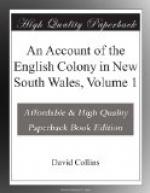Teething 23 have died
Dysentery 45
Cholera morbus 1,
obstipation 1 2
Fevers 7,
consumptions 8 15
Debility 22
Lues venerea 5
Dropsy 3,
putrid sore throat 1 4
Convulsions and epilepsy 4
Surfeit 2, scalded 1,
abscess and canker 2 5
Eruptions, scald head,
and mortifications 3
Iliac passion 1
Shot 1, casualties 2, executed 1, suicide 2 6
Ophthalmia 2
—–
Total 137
STATE OF THE FLAX MANUFACTORY
Not more than nine men and nine women can be employed in preparing and manufacturing the flax, which barely keeps them in practice. There is only one loom on the island, and the slay or reed is designed for coarse canvas; nor do they possess a single tool required by flax-dressers or weavers, beyond the poor substitutes which they are obliged to fabricate themselves. If there were introduced proper slays or reeds, brushes, and other articles indispensably necessary for flax-dressing and weaving, with more people to work the flax and a greater number of weavers, this island would soon require very little assistance in clothing the convicts; but, for the want of these necessary articles, the only cloth that can be made is a canvas something finer than No 7, which is thought to be equally strong and durable as that made from European flax.
This useful plant needs no cultivation. An experiment has been made to cultivate it, and answered extremely well; but the produce was not so much superior to that growing in a natural state as to make it advisable to bestow any pains on its culture.
Before the arrival of the two New Zealanders in May 1793, no effectual progress had been made in its manufacture; nor was it without much entreaty that our visitors were induced to furnish the information we required. And indeed, as this work is principally performed by the women in New Zealand, our friends were by no means competent to give us the fullest instructions. Sufficient, however, was obtained from them to improve upon. Since that time those women that could be spared from other work, not exceeding from six to twelve, had been employed in preparing the flax; and a flax-dresser, weaver, and three other assistants, in manufacturing it into canvas, rope, etc.
When the leaves are gathered, the hard stalk running through the centre is taken out with the thumb-nail; and the red edges of the leaf are also stripped off. The two parts are then separated in the middle, making four slips of about three-quarters of an inch wide, and the length of from eighteen inches to three or four feet. These slips are cut across the centre with a muscle-shell, but not so deep as to separate the fibres, which is the flax. The slips thus




